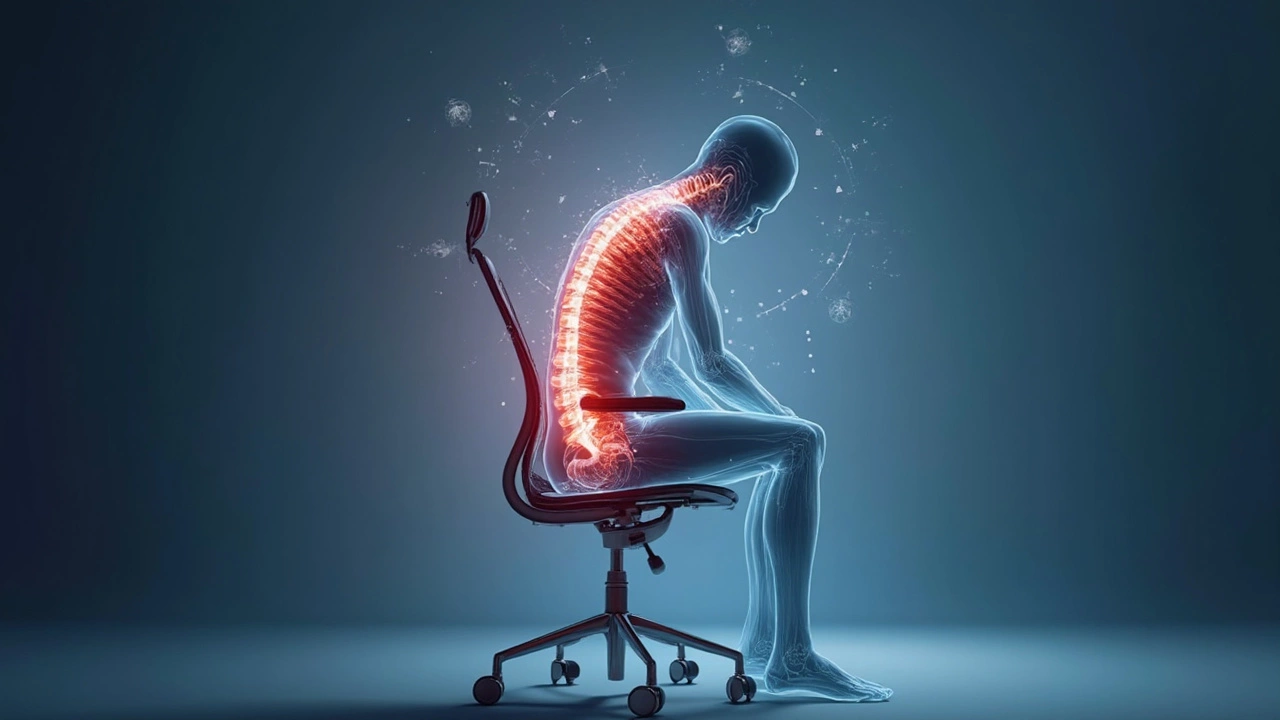 8
Jun,2025
8
Jun,2025
Ever caught yourself hunched over your keyboard like a pretzel, shoulders drooping and your head poking forward? That’s not just uncomfortable, it’s basically a masterclass in how to wreck your back, neck, and even your mood at work. The truth is, the most unhealthy sitting position is when you’re slouching—or what experts call the “forward head posture” or “rounded shoulders.” This is the posture you slip into when you let your lower back collapse, your shoulders roll forward, and your head drifts in front of your body, usually toward your screen.
Sitting like this doesn’t just make your back hurt. Over time, it strains your spine, tightens your chest, puts annoying pressure on your lower back and can even mess with nerve signals. It might not hurt right away, but after weeks or months, you’ll probably feel those aches creep in when you least expect it. The scary part? Studies have shown this posture can even drop your energy levels and affect your confidence. So, yeah—it’s more than just an annoying habit.
- What Does the Most Unhealthy Sitting Position Look Like?
- Why Slouching Is Worse Than You Think
- Surprising Effects on Your Body and Mind
- Real-World Tips to Ditch Bad Posture
- How to Set Up Your Office Chair the Right Way
What Does the Most Unhealthy Sitting Position Look Like?
If you’ve ever found yourself starring in the classic office chair slouch, you’re not alone. The unhealthy sitting position takes many shapes, but the worst is the one with your back rounded, shoulders slumped forward, and head jutting out over your chest. Think of someone texting for hours or a gamer glued to their screen. That’s the posture that messes you up fastest.
Here’s what this body-busting position usually involves:
- Your lower back is collapsed—or you’re sitting on your tailbone instead of your sit bones.
- Shoulders are rolled forward, almost as if you’re trying to become one with your desk.
- Head stretches forward past your shoulders, making your neck work overtime against gravity.
- Hips slide forward, while your knees might be way higher than your hips.
- Feet dangle off the floor or tuck under the chair, instead of being planted flat.
So, why do people end up like this? Bad chair setup, long hours without breaks, and plain old habit. It’s easy to lose track when you’re focused on a spreadsheet or lost in a video meeting.
You might think this posture is no big deal, but check out the numbers:
| Problem | Percentage Reported |
|---|---|
| Low Back Pain (from sitting long hours) | 38% |
| Neck and Shoulder Pain | 27% |
| Poor Posture at Work | 32% |
Those stats come from surveys of office workers sitting more than 6 hours a day. It’s not just a random ache here and there—it’s a pattern that follows this exact sitting style.
So next time you notice your back rounding and chin poking out, remember: this position isn’t just “bad,” it’s the fastest way to join the back pain club. Fixing it takes some awareness, a few adjustments, and, honestly, a little stubbornness.
Why Slouching Is Worse Than You Think
Most people know slouching looks bad, but not everyone gets just how much damage it does. Sitting with your back rounded or shoulders slumped puts a lot of pressure on your spine and can mess with nerves, muscles, and even how well your organs function. Over time, the body adapts to this position, and that’s when you get all sorts of annoying issues—stubborn back pain, neck stiffness, even headaches and fatigue.
When you settle into a slouch, your lower back isn’t getting the support it needs, so the muscles around your spine get weaker while others overcompensate and tense up. What does that mean in real life? More trips to the doctor, more days feeling off, and maybe even a few missed outings because your body just doesn’t bounce back. Here’s what we know is actually happening inside your body when you keep sliding into the unhealthy sitting position:
- Your head shifts forward, putting up to 60 pounds of extra force on your neck (that’s like carrying a kid around on your neck all day, according to a study in Surgical Technology International).
- Your lungs can’t expand as well, so it’s harder to breathe deeply. Researchers at the University of Western Australia found a big drop in lung capacity just from hunching over for long stretches.
- Your digestion slows down. If you eat lunch and keep slouching, your stomach is squished, which can lead to reflux or bloating.
Personal trainers and physical therapists say these issues don’t just fade away if your workday is mostly at a desk. And check this out—an ergonomic survey in 2023 showed that 86% of office workers complain of musculoskeletal pain after a year of regular slouching at their workstation. That's not a small number.
| Problem | What Happens | Potential Result |
|---|---|---|
| Rounded back/slouch | Spinal discs compressed | Chronic lower back pain |
| Shoulders rolled forward | Muscle imbalance | Stiff neck and headaches |
| Head juts forward | Extra force on neck | Nerve irritation, fatigue |
The main point: Slouching while sitting hits way more than just your lower back. Those awkward aches might be just the start, and the longer you ignore it, the worse things tend to get.

Surprising Effects on Your Body and Mind
Turns out, slouching at your desk does way more than just leave you sore at the end of the day. When you stick with the unhealthy sitting position, you might be asking for trouble that stretches far beyond a stiff neck. Here’s why: slumping actually compresses your lungs, cutting their capacity by up to 30%. That means less oxygen gets to your brain, which can leave you feeling sluggish and slow on the uptake.
It gets worse. Bad posture can mess with your digestive system. When you’re hunched, your organs get squished, slowing down digestion and sometimes leading to bloating. Have you ever wondered why you feel so drained after a long day at your desk? That rounded, forward-leaning posture signals your body to work less efficiently in just about every way it can. Some research from Harvard even points out that people with poor posture have higher levels of cortisol—the stress hormone—and lower confidence scores.
It’s not just physical, either. Your mental health gets dragged down. Slouching is linked to more negative thoughts and low moods, while sitting up straighter can boost your memory and energy. On top of that, your productivity might take a hit because pain and discomfort become a constant distraction.
| Effect | Details |
|---|---|
| Lung Capacity | Reduced by up to 30% when slouching |
| Digestive Issues | Slower digestion, bloating from organ compression |
| Mood Changes | Higher stress, lower confidence |
| Productivity | More fatigue and distractions |
If you’re spending hours in front of a screen, these issues add up quickly. That’s why taking your sitting habits seriously isn’t overkill—it’s just smart self-care. Some small adjustments can totally change how you feel, think, and even how you show up at work.
Real-World Tips to Ditch Bad Posture
If you keep falling into bad habits with your desk set-up, you’re definitely not alone. Most people don’t notice their posture slipping until their back or neck starts nagging. Fixing it is absolutely doable—even in a busy office.
First off, remind yourself: good posture isn’t about sitting like a statue all day. It means keeping your head, spine, and hips in a straight line as much as possible, and moving around often.
- Unhealthy sitting position alert: Take a photo of your normal work posture. Does your head stick out past your shoulders? If yes, it's a sign you need to adjust.
- Raise your screen so the top is about eye level. This keeps you from craning your neck forward.
- Keep feet flat on the floor—no crossing legs or tucking them under the chair.
- Use a small rolled-up towel or a lumbar pillow at your lower back for extra support (try it for a week—the difference is obvious fast).
- Set a timer on your phone as a reminder to get up and move every 45-60 minutes. Just a minute of stretching or a quick walk to the water cooler helps a lot.
- Chair adjustment is key: your knees should be level with or just below your hips. If your chair doesn’t do this, try a footrest or a stack of books under your feet.
Want numbers? Here’s what research says about how much movement makes a difference:
| Habit | Recommended Frequency | Proven Benefit |
|---|---|---|
| Stand up and stretch | Every 30-60 min | Reduces back pain by 30% (source: CDC study, 2021) |
| Desk height check | Once per week | Better alignment, less neck strain |
| Posture reminders | Daily | Improved long-term spinal health |
If you’re really stuck and can’t get comfy, those posture tracker gadgets or free phone apps that nudge you to sit up straight actually work for a lot of folks, including my friend who works in IT and swears by them.
Bottom line—you don’t have to overhaul your whole office to start feeling better. A few small changes can wipe out all the worst parts of slouching. Your future self will seriously thank you.

How to Set Up Your Office Chair the Right Way
If you want to avoid the most unhealthy sitting position, a good setup matters more than you think. The right way to set up your chair isn’t just a nice-to-have. It supports your back, makes working easier, and can actually lower your risk of aches, headaches, and fatigue. Here’s what makes the biggest difference:
- Seat Height: Adjust your chair so your feet are flat on the floor — not dangling, not tiptoed. Your knees should be about level with your hips.
- Backrest Support: Make sure your lower back touches the chair’s support. Some chairs have built-in lumbar support, but if not, stick a cushion there. This keeps your spine in a natural curve.
- Armrests: Adjust them so your shoulders aren’t shrugged or slumping. Your elbows should fall just below 90 degrees and rest gently, not pressing hard.
- Seat Depth: Sit back fully so there’s about a two-finger gap between the edge of the seat and the back of your knees. If the seat’s too deep or shallow, your posture will suffer.
- Screen Height and Distance: This one gets overlooked but matters a ton. The top of your monitor should be at or slightly below eye level, about an arm’s length away. No craning forward to squint!
Here’s a quick cheat sheet you can pull up and double-check:
| Chair Part | Proper Adjustment |
|---|---|
| Seat Height | Feet flat, knees even with hips |
| Lumbar Support | Natural curve matches your lower back |
| Armrests | Elbows at 90°, shoulders relaxed |
| Seat Depth | 2-3 fingers between seat and knees |
| Screen Placement | Eye level, arm’s length away |
Want something simple? Set a calendar reminder once a week to check your chair and monitor setup. It sounds over-the-top, but it beats weeks of back pain. My wife Lucy used to ignore her chair height, and her legs would go numb by lunch—adjusting the seat fixed it overnight.
One last tip: get up and move every 30-45 minutes, even just to grab a glass of water. No chair can fix being frozen in place for hours, no matter how ergonomic.




